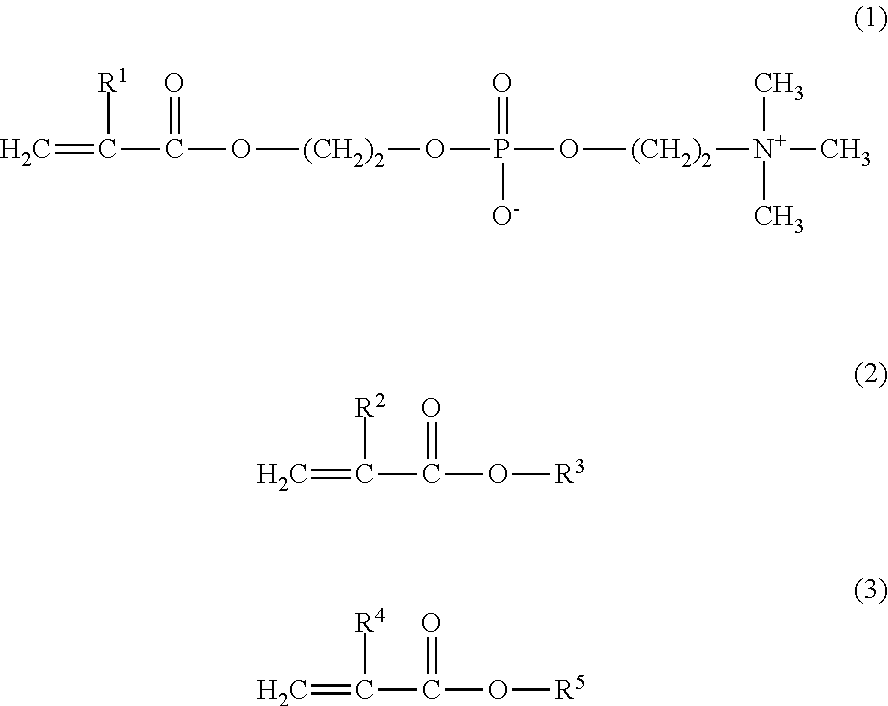Protein stabilizer and protein stabilization reagent
a protein stabilization and reagent technology, applied in the field of protein stabilizers, can solve the problems of high risk of infection, failure to achieve satisfactory stabilization effect, and extremely low long-term stability of proteins in solution, so as to achieve stable protein storage, improve the protein stabilization effect of reagents, and prevent viscosity increase of reagents
- Summary
- Abstract
- Description
- Claims
- Application Information
AI Technical Summary
Benefits of technology
Problems solved by technology
Method used
Image
Examples
synthesis example 1 (
Synthesis of Copolymer 1)
[0053]8.4 g of MPC, 4.5 g of GLM, and 2.1 g of BMA were weighed and introduced into a glass flask for polymerization. 0.147 g of 2,2′-azobisisobutyronitrile (hereinafter referred to as AIBN) was added thereto as a polymerization initiator, and 42.5 g of a purified water and 42.5 g of ethanol were further added thereto as polymerization solvents. Thus, the mole ratio of the monomers MPC / GLM / BMA was 40 / 40 / 20. The internal air in the reaction container was sufficiently replaced with nitrogen, and then the monomers were polymerized under heating at 55° C. for 5 hours. The resultant reaction liquid was cooled with ice, and was added to diethyl ether dropwise to precipitate the product. The precipitate was isolated by filtration, washed with diethyl ether, and dried under vacuum, to obtain a white powder of the copolymer 1.
[0054]The obtained copolymer 1 was dissolved in a phosphate buffered saline, and the resultant solution was subjected to an analysis using a ge...
synthesis example 2 (
Synthesis of Copolymer 2)
[0064]11.4 g of MPC, 3.1 g of GLM, and 5.5 g of BMA were weighed and introduced into a glass flask for polymerization. 0.730 g of AIBN was added thereto as a polymerization initiator, and 40.0 g of a purified water and 40.0 g of ethanol were further added thereto as polymerization solvents. Thus, the mole ratio of the monomers MPC / GLM / BMA was 40 / 20 / 40. The internal air in the reaction container was sufficiently replaced with nitrogen, and then the monomers were polymerized under heating at 55° C. for 5 hours. The resultant reaction liquid was cooled with ice, and was added to diethyl ether dropwise to precipitate the product. The precipitate was isolated by filtration, washed with diethyl ether, and dried under vacuum, to obtain a white powder of the copolymer 2.
[0065]The obtained copolymer 2 was dissolved in a phosphate buffered saline, and the resultant solution was subjected to a GFC analysis. As a result, the copolymer 2 had a weight-average molecular we...
synthesis example 3 (
Synthesis of Copolymer 3)
[0066]4.7 g of MPC and 5.3 g of BMA were weighed and introduced into a glass flask for polymerization. 0.244 g of AIBN was added thereto as a polymerization initiator, and 27.0 g of a purified water and 63.0 g of ethanol were further added thereto as polymerization solvents. Thus, the mole ratio of the monomers MPC / BMA was 30 / 70. The internal air in the reaction container was sufficiently replaced with nitrogen, and then the monomers were polymerized under heating at 55° C. for 5 hours. The resultant reaction liquid was cooled with ice, and was added to diethyl ether dropwise to precipitate the product. The precipitate was isolated by filtration, washed with diethyl ether, and dried under vacuum, to obtain a white powder of the copolymer 3.
[0067]The obtained copolymer 3 was dissolved in a phosphate buffered saline, and the resultant solution was subjected to a GFC analysis. As a result, the copolymer 3 had a weight-average molecular weight of 93,000 in terms...
PUM
| Property | Measurement | Unit |
|---|---|---|
| temperature | aaaaa | aaaaa |
| temperature | aaaaa | aaaaa |
| temperature | aaaaa | aaaaa |
Abstract
Description
Claims
Application Information
 Login to View More
Login to View More - R&D
- Intellectual Property
- Life Sciences
- Materials
- Tech Scout
- Unparalleled Data Quality
- Higher Quality Content
- 60% Fewer Hallucinations
Browse by: Latest US Patents, China's latest patents, Technical Efficacy Thesaurus, Application Domain, Technology Topic, Popular Technical Reports.
© 2025 PatSnap. All rights reserved.Legal|Privacy policy|Modern Slavery Act Transparency Statement|Sitemap|About US| Contact US: help@patsnap.com



